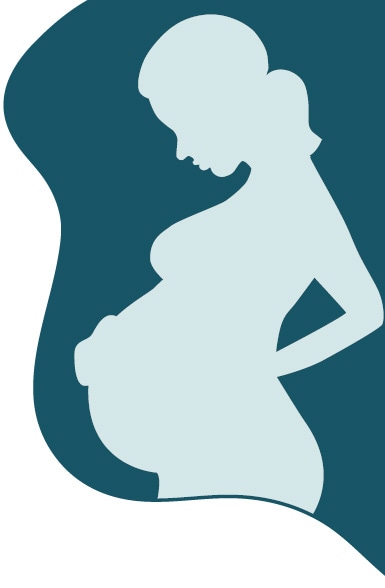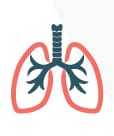Women with Sickle Cell Disease and Prenatal Care
What to Know During Pregnancy

Prenatal care is health care you get while you are pregnant. Regular prenatal care is important for everyone. It is especially important for women with sickle cell disease (SCD) because they are at greater risk for developing complications (health problems) during pregnancy than women without SCD. Pain crises and other SCD complications can become more severe or increase in frequency while you are pregnant, but regular care can help you manage and prevent complications. Learn what steps you can take to help stay healthy throughout your pregnancy.
Schedule regular medical appointments. In addition to your prenatal care provider and your SCD provider, your healthcare team might also include a maternal-fetal medicine specialist (an obstetrician/gynecologist specializing in complicated or high-risk pregnancy). You will need to be seen for prenatal care every month, or more often as delivery approaches, to monitor your health and the health of your baby. You also might need additional ongoing visits with your SCD provider and other specialists.
Protect yourself while pregnant against infections, such as flu, COVID-19, and whooping cough. Review your current vaccination record with your care team to make sure you are up to date on all needed vaccines (shots). Vaccines are safe for people with SCD, and most are also safe to use during pregnancy. Additional vaccines are recommended for people with SCD to help prevent harmful infections.
Ask your care team about testing for you and your partner to learn about the chance of having a child with SCD. Your care team may also discuss tests to diagnose SCD while your baby is in your womb. These tests can check for genetic abnormalities in the baby. Talk to a genetic counselor about the results of any tests that are done (mother, father, or fetal testing) to understand the chance of having a baby born with SCD.
Talk with your care team about your pain, pain management plan, medicine doses, and how your medicines might affect your baby and how changes in your medication might affect you. If you regularly take opioid medicines for pain, your newborn might experience neonatal abstinence syndrome (a withdrawal syndrome that can occur in newborns after being exposed to certain drugs or medicines during pregnancy).
Try to avoid extreme temperatures, high altitudes, dehydration, and other conditions or activities that can trigger pain for you.
Discuss any changes needed to your treatment plan with your care team if you did not already do so before getting pregnant. Talk with your care team about ways to treat your SCD and prevent and manage complications during pregnancy, such as blood clots.
Women are at increased risk for blood clots during pregnancy, childbirth, and the three-month period after delivery. Discuss with your care team the need for anticoagulants (blood thinners) based on your health history.
Pregnant women with SCD are at increased risk for preeclampsia (a high blood pressure condition that occurs after the 20th week of pregnancy). Your care team may prescribe low-dose aspirin to help prevent preeclampsia.
Know that your body will change during pregnancy. You can experience changes to your breathing and feel discomfort in different areas of your body, such as your hips and back. However, there are urgent maternal warning signs that can signal a more serious health problem. These signs should not be ignored. Seek medical care immediately if you experience any urgent warning signs. Make sure your doctor knows you are pregnant and have SCD.
Urgent Maternal Warning Signs:
(Get medical care right away if you experience any of the following)

Headache that won’t go away or gets worse over time

Dizziness or fainting

Changes in your vision

Fever of 100.4˚F higher

Overwhelming tiredness

Extreme swelling of your hands or face

Thoughts of harming yourself or your baby

Trouble breathing

Chest pain or fast beating heart

Heavy vaginal bleeding or discharge after pregnancy

Severe nausea and throwing up

Severe belly pain that doesn’t go away

Baby’s movement stopping or slowing during pregnancy

Severe swelling, redness or pain of your leg or arm

Vaginal bleeding or fluid leaking during pregnancy
- Eat a balanced diet and follow steps for food safety to prevent foodborne illnesses, such as listeria and salmonella.
- Drink plenty of water to stay hydrated. If you have heart or kidney disease, ask your care team how much water is recommended for you.
- Avoid alcohol and tobacco products.
- Unless told otherwise by your care team, stay physically active. Ask your care team what types of exercises may be appropriate for you.
- Ask your care team if you need a vitamin without iron. Some women with SCD may have high amounts of iron in their blood from blood
transfusions and may need to take a prenatal vitamin without iron. - Folic acid is a B vitamin that is important to have both before and during pregnancy. Folic acid is used by the body to make new cells. This
includes the cells that will form the baby’s brain and spine. Thus, it is particularly important to talk with your provider to ensure you are getting enough folic acid.
Let your care team know now about your breastfeeding plan so that you can discuss if any changes are needed to your treatment plan after delivery. Some medicines are not recommended to use while breastfeeding.
Discuss and develop a support plan with your partner, family, and employer on issues during pregnancy and after delivery. Topics can include the following:
- Care for other children or family members and managing household chores.
- The signs and symptoms of postpartum depression.
- Managing work schedules with your employer.
- Follow up with your SCD provider after delivery.
Develop a birth plan to help make informed decisions and to share your preferences for labor and delivery. Know that these plans may change if you have a complicated pregnancy or emergency delivery. Your birth plan can include the following topics:
- Who you want present during labor and delivery.
- Plan for delivery, such as vaginal or planned cesarean birth. If you have avascular necrosis (a serious condition that results in the death of bone tissue due to a lack of blood supply) of your hips, this can affect delivery positions. Ask questions about the risks and benefits of what is recommended for you.
- The use of pain medicines or alternative methods of pain relief, such as massage, breathing techniques or meditation during and after delivery.
Consider your plans for contraception (birth control) after having the baby. Birth control can sometimes be started immediately after delivery and not just at a later visit. If interested in birth control, talk with your care team to learn about all the options for birth control that are safe for women with SCD.
- https://www.cdc.gov/pregnancy/during.html
- https://www.cdc.gov/ncbddd/sicklecell/facts.html
- https://www.smfm.org/members/search
- https://www.cdc.gov/vaccines/pregnancy/vacc-during-after.html
- https://www.cdc.gov/vaccinesafety/concerns/vaccines-during-pregnancy.html#Not
- https://www.cdc.gov/ncbddd/sicklecell/healthyliving-prevent-infection.html
- https://www.cdc.gov/pregnancy/opioids/basics.html
- https://www.cdc.gov/ncbddd/dvt/pregnancy.html
- https://www.cdc.gov/bloodpressure/pregnancy.htm
- https://www.cdc.gov/hearher/maternal-warning-signs/index.html
- https://www.myplate.gov/
- https://www.foodsafety.gov/people-at-risk/pregnant-women
- https://www.cdc.gov/ncbddd/folicacid/index.html
- https://www.acog.org/womens-health/faqs/postpartum-depression
- https://www.thebump.com/a/tool-birth-plan
- https://www.cdc.gov/ncbddd/sicklecell/complications.html#necrosis
- https://www.cdc.gov/reproductivehealth/contraception/index.htm
Sickle Cell Red: Planning for Pregnancy with SCD:
https://sicklecellred.org/learners/
10 Tips for Preventing Infections Before and During Pregnancy:
https://www.cdc.gov/pregnancy/infections.html
Vaccine Safety for Moms-To-Be:
https://www.cdc.gov/vaccines/pregnancy/vacc-safety.html
U.S. Department of Health & Human Services: Office on Women’s Health:
https://www.womenshealth.gov/a-z-topics/sickle-cell-disease
March of Dimes: Sickle Cell Disease and Pregnancy:
https://www.marchofdimes.org/find-support/topics/pregnancy/sickle-cell-disease-and-pregnancy
What to Expect: Sickle Cell Disease During Pregnancy:
https://www.whattoexpect.com/pregnancy/pregnancy-health/sickle-cell-disease-during-pregnancy/#sickle
Babycenter: Sickle Cell Disease and Pregnancy:
https://www.babycenter.com/pregnancy/health-and-safety/sickle-cell-disease-and-pregnancy_10420020
University of Rochester Medical Center: Sickle Cell Disease and Pregnancy:
https://www.urmc.rochester.edu/encyclopedia/content.aspx?ContentTypeID=90&ContentID=P02499
Women with Sickle Cell Disease and Preconception Care: What to Know Before Getting Pregnant:
https://www.cdc.gov/ncbddd/sicklecell/materials/women-with-scd-preconception-care.html
Women with Sickle Cell Disease and Postpartum Care: What to Know After Delivering Your Baby:
https://www.cdc.gov/ncbddd/sicklecell/materials/women-with-scd-postpartum-care.html
